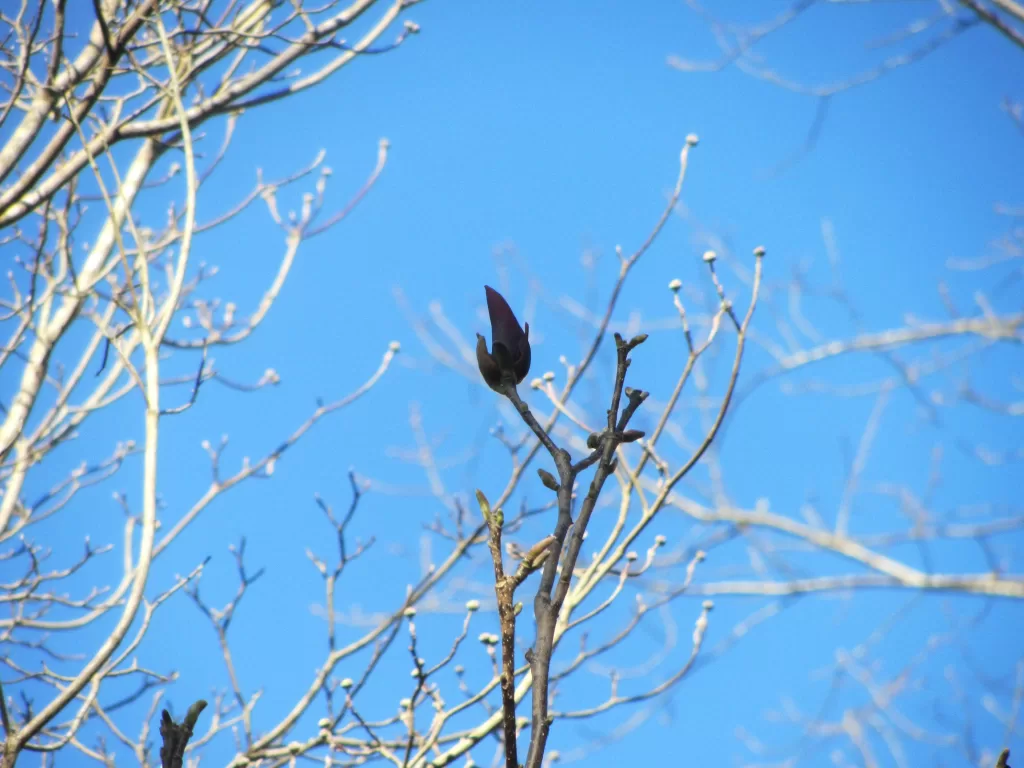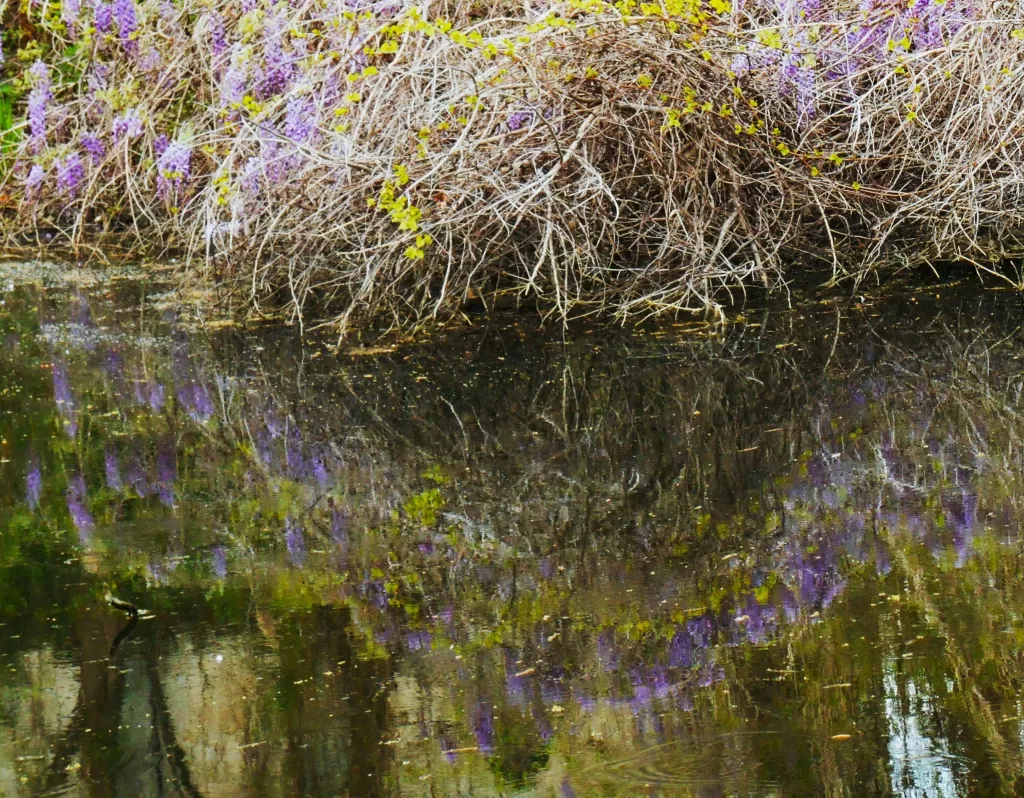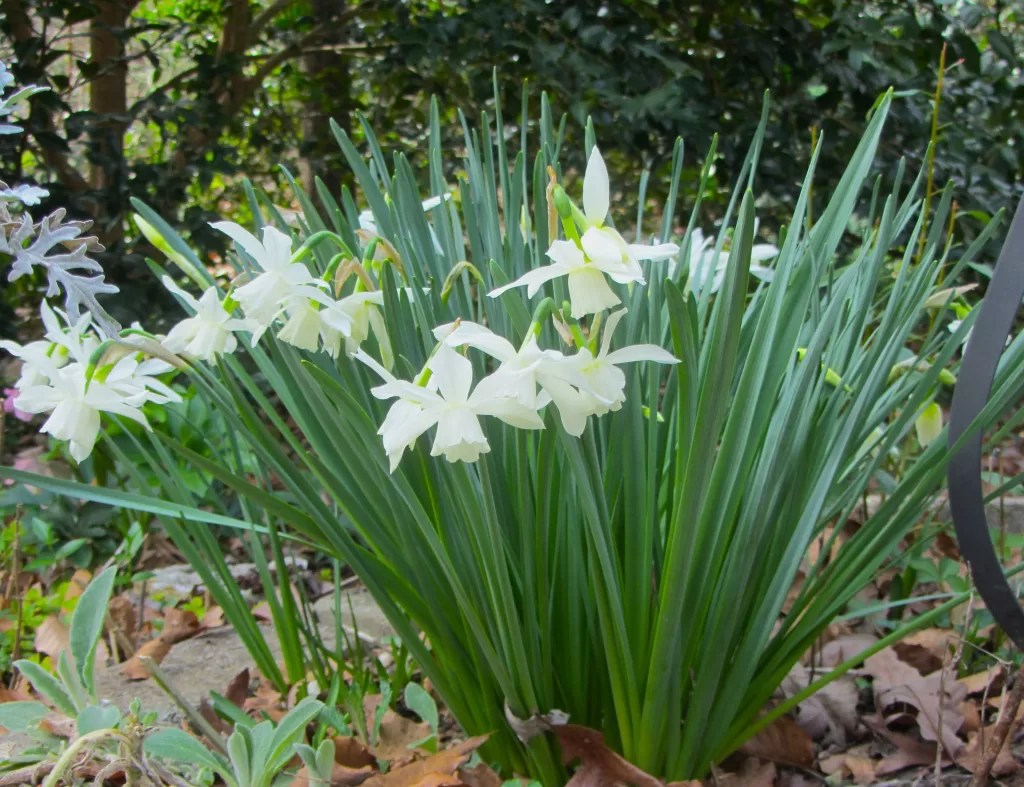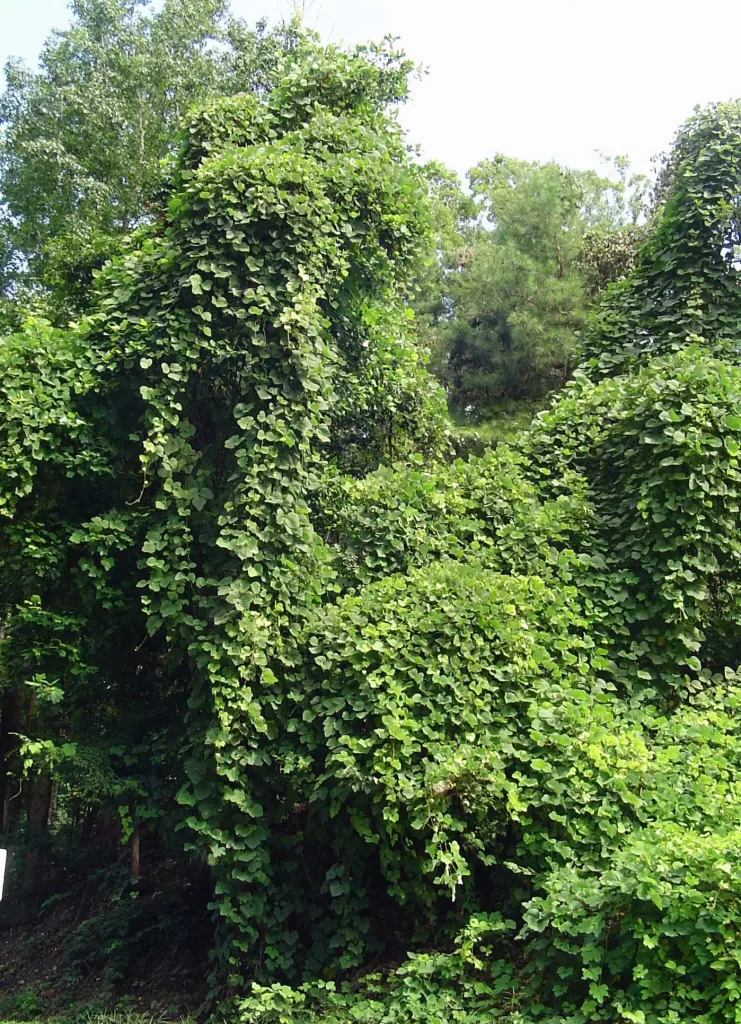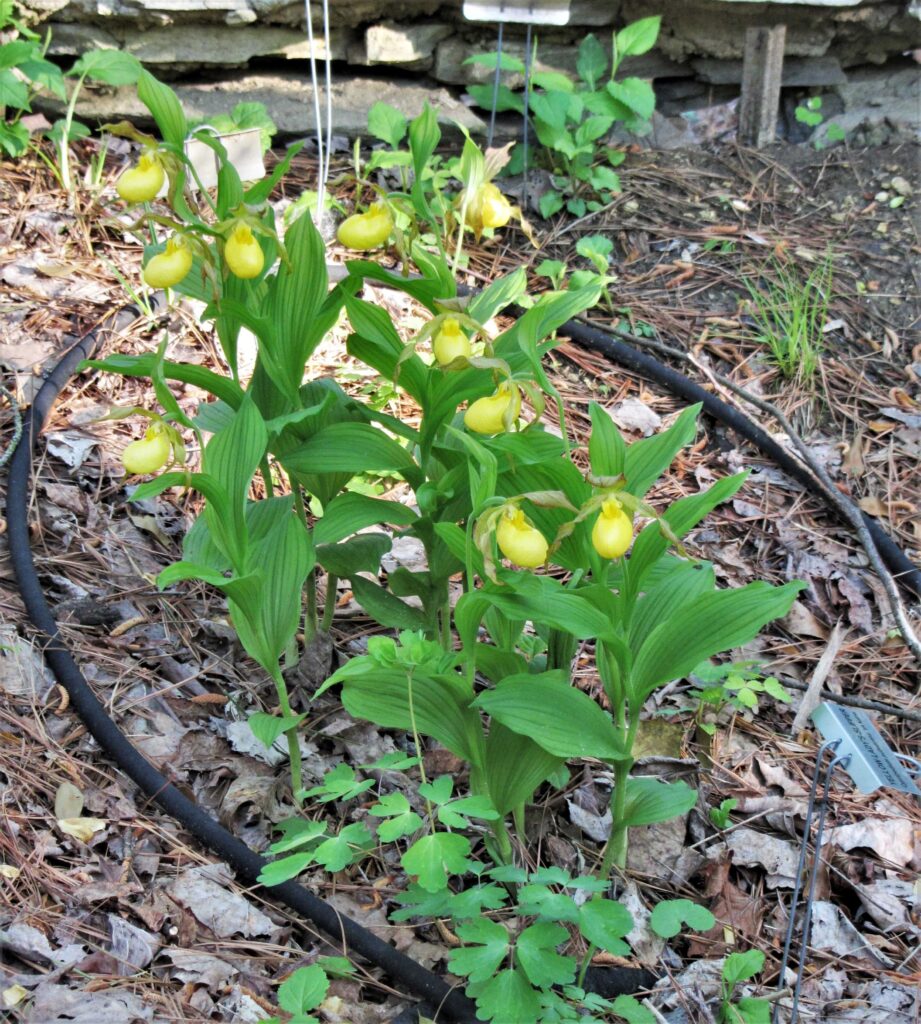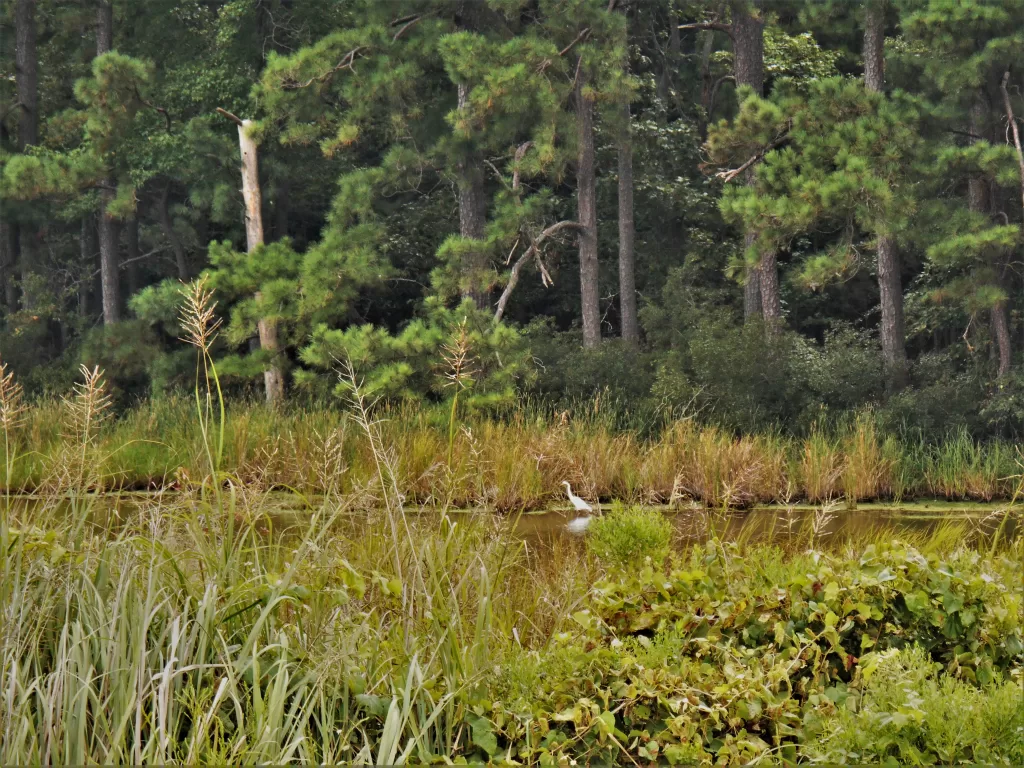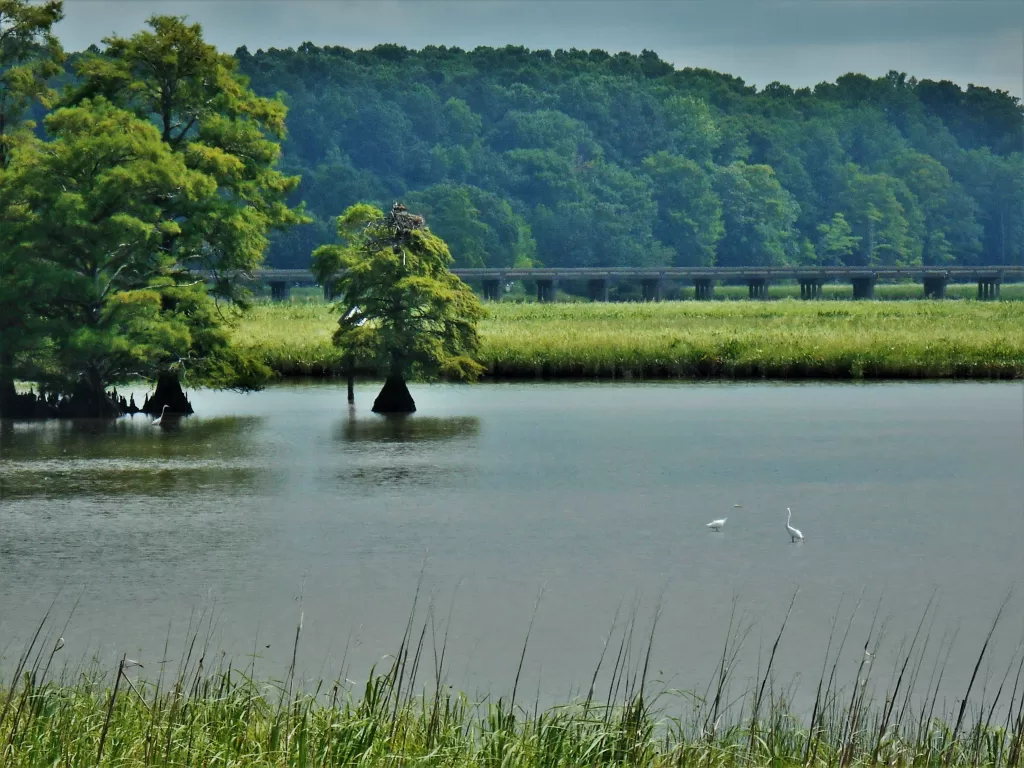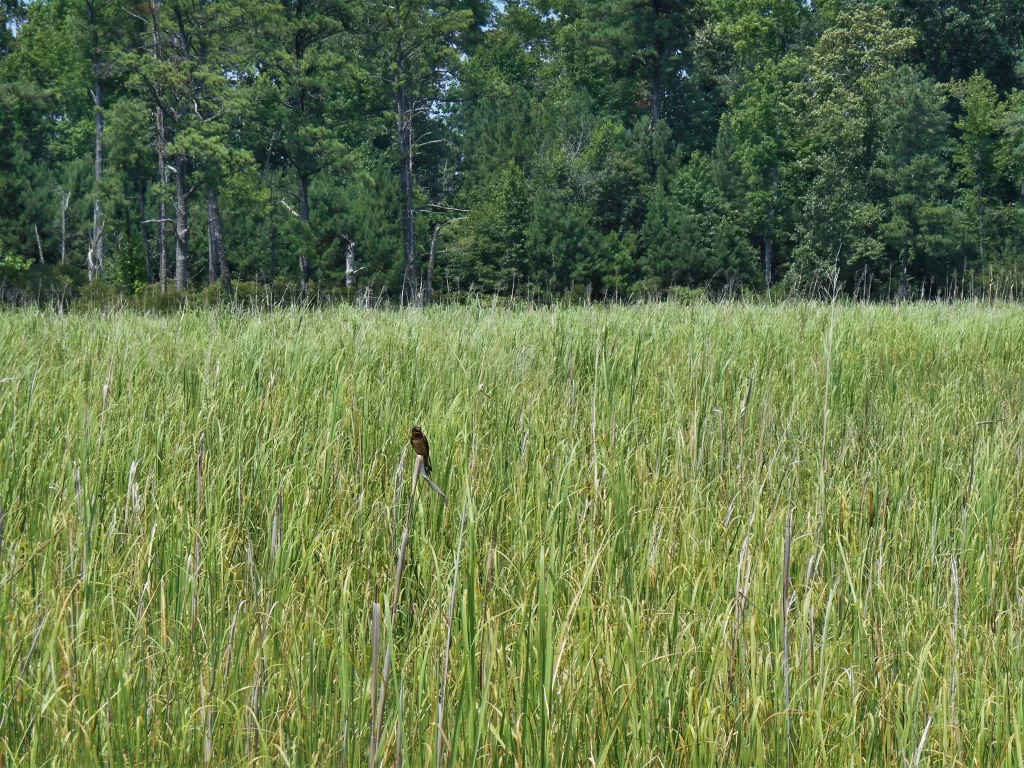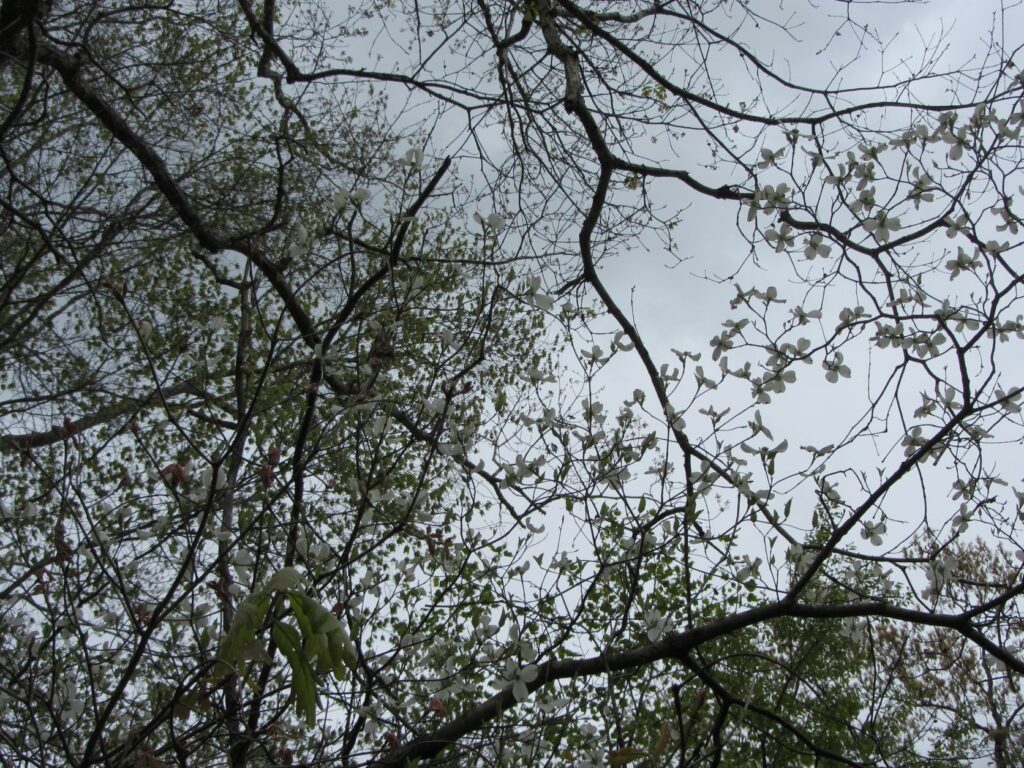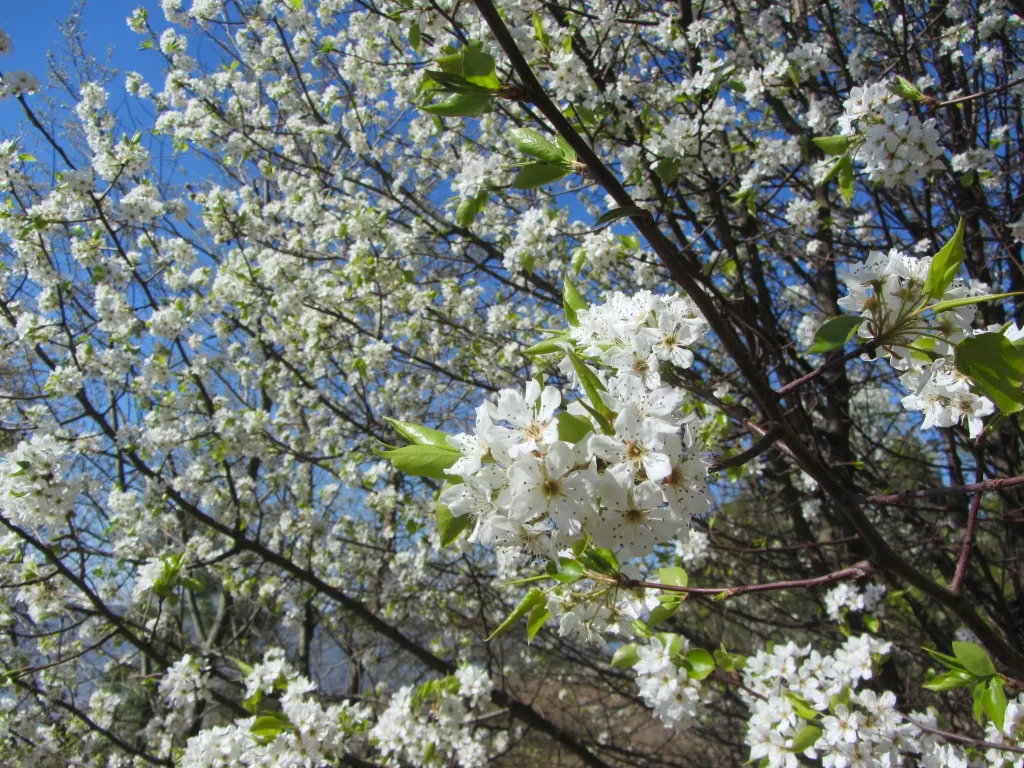A History of Our War With Plants
An Asian Magnolia blooms alongside native dogwood and oak. March 2024
“I use only native plants, native to the planet Earth. I am using indigenous plants; they are indigenous to this part of the universe.”
Bill Mollison, Founder and Director of The Permaculture Institute
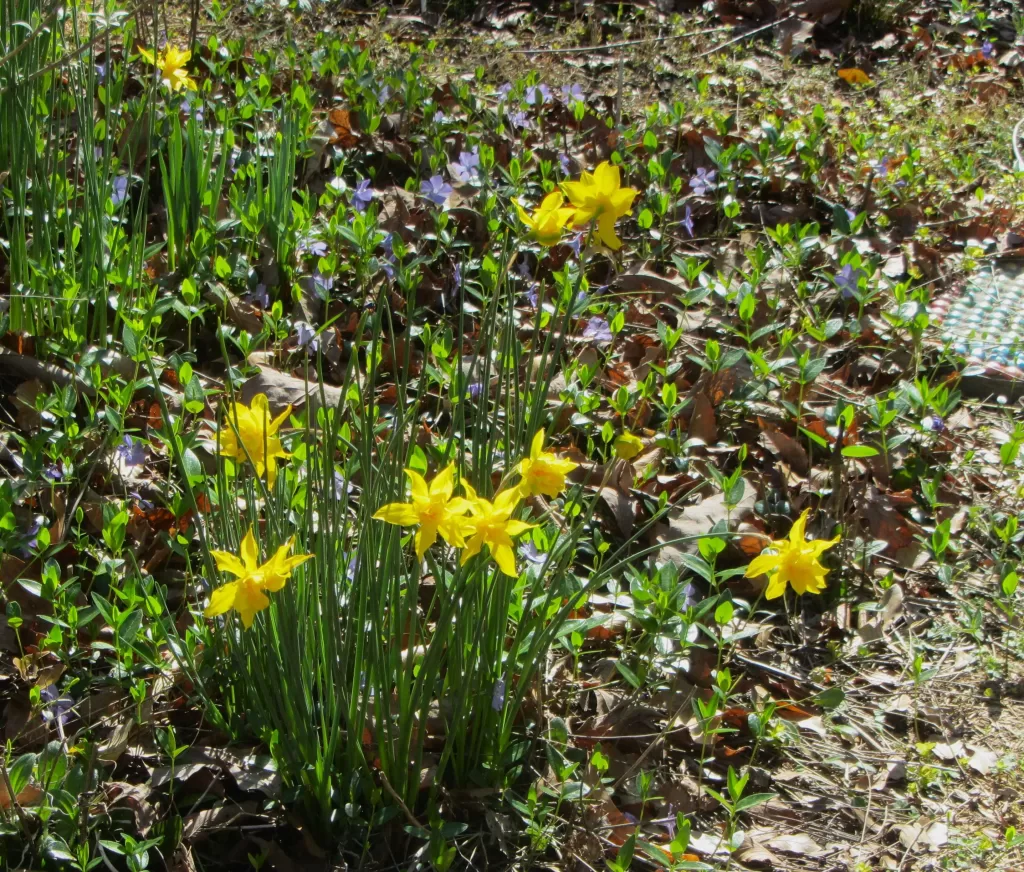
Narcissus x odorus flore pleno or Queen Anne’s double jonquil, is a 1601 introduction brought to Virginia by English colonists. Vinca minor, blooming in blue, remains on Virginia’s invasive species list even though to is a tough, drought resistant ground cover which supports wildlife. March, 2024
In the Beginning…
Let’s begin with the obvious: we live within an ever-changing ecosystem. Europeans came to North America more than four centuries ago, cutting trees, planting fields, building homes and roads. Native Americans also cut trees, built homes, planted fields, hunted, and lived on this land for millennia before the first European explorers and colonists arrived. So whatever pristine, indigenous ecosystem may have once functioned here is lost in the distant mists of time.
In our hubris, we often forget that Native Americans also moved plants around from place to place. They selected the best corn, beans, squash, and other foods to save their seeds; developed their own strains of favorite foods; traded them, and carried them along as they moved from one area to another. They cultivated medicinal plants, herbs, nutritious tubers, and they shaped the land in their own ways.
In Search of Profit and Spice
Europeans sought useful plants during their voyages of discovery for more than a thousand years; bought them, sold them, traded them, and cultivated them at home and in their colonies abroad. Remember the journeys of the Polo family, journeying from Venice to China in the 13th century while trading the precious saffron bulb, Crocus sativus, among other things. Native to the Mediterranean region, saffron has been used as spice, ornament, and medicine throughout recorded history. The ‘Age of Exploration’ was founded in the search for Asian spices.
From before the Crusades until yesterday, the search for useful, profitable, beautiful plants persisted. And not just among Europeans and Native Americans. Trade between indigenous peoples from the South Pacific, India, Africa, South America, China and Southeastern Asia has always included profitable and useful plants. Archeologists and anthropologists document this trade extending back to the earliest traces of human civilization. Oceans were no barrier, we now understand, and land long submerged once held the highways of empire.
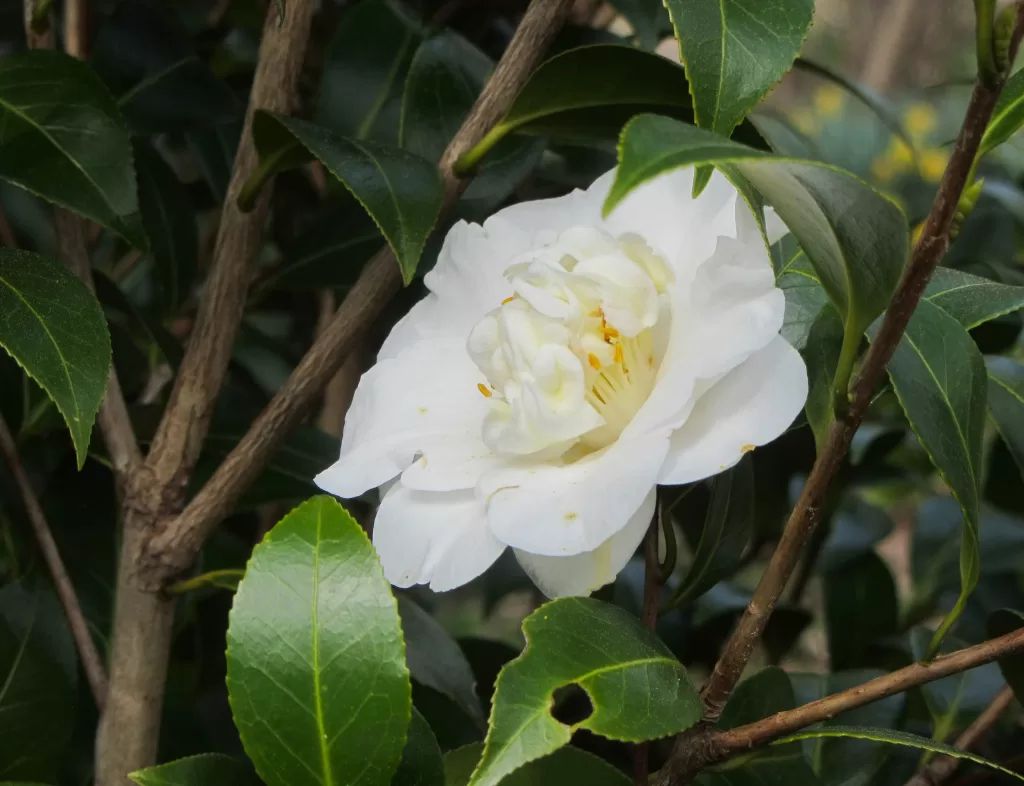
Introduced species, like this Camellia japonica ‘Victory White,’ feed and provide habitat to a variety of animal species while functioning in the landscape. Pollinators feed on Camellias long before most native species in our area bloom. March, 2024.
Accidental Introductions, and Otherwise
Often new plants and animals are introduced accidentally. Imagine the coconut carried across the sea on the tide, or mollusks clinging to the hull of a ship. See the accidental biotic passenger in a ship’s ballast or cargo, and seeds excreted by a sea bird or sea mammal in a new land. Even seeds carried for hundreds of miles on the wind in a storm. These things happen, and have happened, over millions of years. New species colonize wherever favorable conditions permit their survival.
European colonists brought their own useful, familiar plants to North America even as they searched for useful species to send back home. They brought plantain and dandelions, cabbages and ivy, boxwood and daffodils. The collected seeds and seedlings and learned about plants the Native Americans used, like tobacco, to send those plants back home to England, Germany, Denmark, France, Spain and Portugal.
Evolution and Ecosystems
Nature is dynamic, resourceful, resilient and in constant flux. Charles Darwin taught us that species come and go. New forms evolve as animals and plants adapt to an ever-changing environment. And it is a purely human construct to label those changes as good or bad. Nature knows infinite variety and is open to endless improvisations and innovations. It is our human nature to cherish the old and fear the new, or to seek out the new while discounting the old. We are fickle beings, telling our own stories to explain our experiences with our environment.
What is relatively new is our attachment to sorting plants into heroes or villains, good or bad, native or invasive, desirable or noxious weeds. In 1800, Thomas Jefferson said,
“[T]he greatest service which can be rendered any country is to add an useful plant to its culture; especially a bread grain. next in value to bread is oil.”
Thomas Jefferson, Summary of Public Service, after September 2, 1800
Industrialization and westward expansion allowed novel plants and animals to spread and take hold across the United States. Congress passed the Lacey Act in 1900 to prohibit the import of any plant or animal known to harm agriculture or horticulture. This law targeted undesirable species that would reduce profits for ranchers and farmers.
Plant Invasion and Agriculture
By 1974, Congress went further by passing the Federal Noxious Weed Act to ban importation of certain plants known to interfere with commerce or agriculture. Novel plants were officially labeled ‘noxious’ for the first time, and it was in the context of harm to American business interests.
In 1958, British zoologist and animal ecologist Charles Elton published The Ecology of Invasions by Animals and Plants, in which he first described novel species, flourishing in areas where they had been introduced, as invaders. Having survived WWII helping to protect Great Britain’s grain supplies from a population of non-native rodents, he framed the movement of species in martial terms rather than ecological ones.
But his book also caught the mood of the post-war era, when the US government developed industrial scale agriculture to feed the people of Europe and Asia to prevent widespread famine abroad while also fueling population growth at home. New, mechanized agricultural tools like tractors and pesticide sprayers came into use along with synthetic fertilizers, insecticides, and herbicides.
Legacies of War
Pesticides are another legacy of the war. Chemical weapons, like nerve gas, were reconfigured to kill insects and rodents. Herbicides developed in Germany and England to destroy enemy crops and cause famine formed the basis of modern industrial herbicides used in agriculture, and now to destroy ‘invasive’ plants. These herbicidal chemical weapons weren’t used during WWII, although the British military tested their herbicide in the Philippines in the 1950s to destroy the crops of communist revolutionaries in Malaya.
The United States went further, using herbicides as chemical weaponry in Southeast Asia beginning in 1962. The United States destroyed crops and the rain forests over ‘enemy’ territory by spraying 19 million gallons of herbicides, including eleven million gallons of Agent Orange during the Vietnam War. Among those manufacturing these chemical weapons were Monsanto and Dow Chemical, leading manufacturers of the herbicides recommended today for the war on ‘invasive’ plant species.
As the wars in Southeast Asia finally ended, new applications were found at home for these lucrative chemical weapons. They were used in the timber industry to kill plants competing with trees destined for harvest. They were used to eliminate ‘weeds’ growing in monoculture agricultural fields and in pastures. Then these chemical weapons came into common use by homeowners working to perfect their lawns and to easily eradicate unwanted plants on their properties. Although some of the herbicides developed mid-century were eventually banned by the EPA, a second generation of herbicides with friendlier names, like ‘Roundup,’ came to market for consumers.
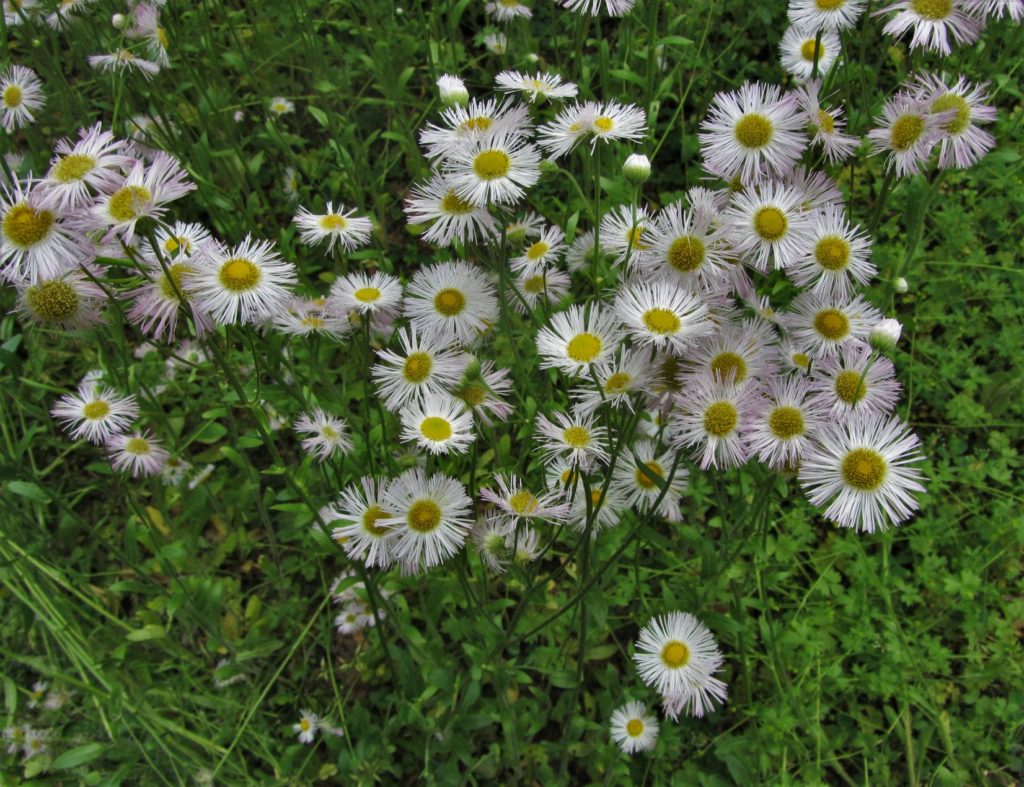
Native fleabane, Erigeron ssp., may be a wildflower or a weed. It depends on your point of view, especially when it blooms in the lawn.
The Invasive Species Advisory Committee, Courtesy of Monsanto Corp. et al
But it wasn’t until 1999 that Bill Clinton signed Executive Order 13112 which created the National Invasive Species Council (NISC) and the Invasive Species Advisory Committee (ISAC). The ISAC is a consortium of academics and professionals that recommend policy for managing invasive species to the NISC. Ironically, Monsanto employee Dr. Nelroy Jackson, who helped to develop glyphosate based herbicides like Roundup and Rodeo, helped to draft EO13112, and then served as Vice-chair of the ISAC. Previously, he served as President of the Western Society of Weed Science and was on the board of the Weed Science Society of America.
The federal NISC, established in 1999, is modeled on a similar California Invasive Plant Council established in 1992, and replicated in other states. These councils bring together representatives of government agencies, non-profit environmental organizations, and the manufacturers of herbicides and herbicide spraying equipment. Monsanto, Dupont, and Dow AgroScience advised and financially supported these groups. In 1993, Dr. Nelroy Jackson published a paper which stated that “chemical weed control is the optimal method for control and removal of exotic plant species during the establishment and improvement of most native habitat and restoration projects.” And that philosophy is now baked into official government agency approaches to eliminating plants that people find undesirable whether in crop lands, forests, residential yards, roadsides, parks, military sites, or wetlands.
Novel Plants: Problems or Solutions?
Today there are around 4,500 novel plant species with self-sustaining populations, that survive without intentional cultivation in the United States. Of those, only around 122 species are officially labeled as ‘harmful’ under current federal law. Ironically, several of these ‘harmful’ or ‘invasive’ species were intentionally introduced by the US Government to solve specific problems in previous decades. An example is Kudzu, an edible Asian vine, introduced to stop erosion and repair depleted soils after the Dust Bowl era and through the 1950s. It is very easy to grow and can be used as animal fodder or cooked for dinner. Others, like multiflora rose, autumn olive, and Scotch broom were introduced as desirable ornamentals for beauty, to control erosion, to form hedges and windbreaks, and to support wildlife.
Japanese knotweed, a medicinal herb containing the polyphenol resveratrol taken to preserve the youthful functioning of cells, is used as a vegetable in Asian cuisine. Introduced to Europe by a Bavarian physician in 1820’s, it was planted at Kew Gardens in the 1850s and widely sold by commercial nurseries. A little over a century later, it had escaped cultivation and was classified as a ‘noxious weed’ by the British government by the 1970s. Japanese knotweed, Reynoutria japonica, is an herbaceous perennial which grows extremely deep roots, cleans up heavy metal and other chemical residues from polluted soil, colonizes abandoned sites, spreads easily in disturbed soil, and covers itself with pretty white flowers beloved by bees. It is now considered an invasive plant across Europe and North America despite its superpowers to clean up polluted sites and provide food and habitat for wildlife.
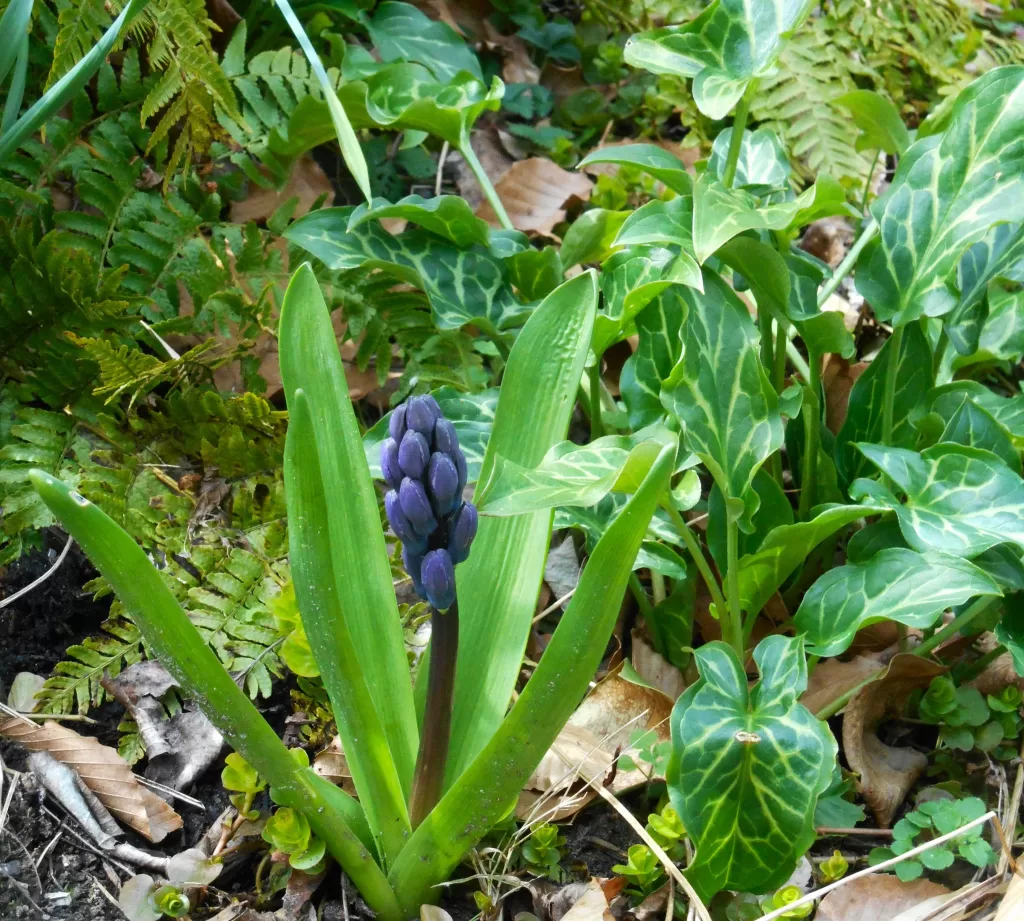
It is hard to predict which newly introduced plants will become darlings or villains in decades to come. Asian ‘Autumn Brilliance’ fern is a reliable, evergreen fern still valued by gardeners. Hyacinths have been beloved for centuries. Evergreen Italian Arum, while not yet classified as invasive does escape cultivation. Removing its seeds before they ripen controls its spread. Creeping Jenny spreads out of control in the blink of an eye, yet is still widely sold in nurseries. March 2024
Reality or Perception?
And although we have identified about 122 ‘invasive’ plant species over the past 25 or so years, we still don’t have an official, widely accepted definition for the term ‘invasive plant.’ These problematic plants are still defined in terms of how they affect human commerce and human aesthetics. There is no deep analysis of how these maligned plants function within the ecosystems where they are found, or why they have found and exploited a niche that wasn’t already filled by native plants.
Virginia’s official list of ‘invasive’ plants currently numbers 90 plants, including 8 ‘early detection species’ not yet widespread in the state. Various local groups publish their own lists which sometimes include species they consider problematic in their area that aren’t yet on the state’s Department of Conservation and Recreation’s list, which is labeled as for educational purposes, only. There is not yet any regulatory authority attached to the plants on this list. This may soon change, as the General Assembly considered a bill this term to regulate the sale of certain plants, which are currently perfectly legal to sell and to plant.

Autumn olive blooms in early spring, then it produces edible fruit in autumn. As birds spread its seeds in their droppings, it has become highly invasive. This small tree crowds and smothers other plants and is nearly impossible to eradicate without herbicides. Autumn olive was planted to stop erosion around strip mining sites, particularly in the mountains of West Virginia, and was once highly recommended for hedges and windbreaks because it is so resilient. But it has had a negative effect on sites where it prevents a normal succession of forest growth. March 2024
Disturbed Environments Welcome Resilient Plants
But ecologists agree that novel plants can become invasive once they take root in disturbed environments where they aren’t used by people or controlled by animal grazing. And we all live, travel, and work in disturbed environments, because we use heavy machinery to clear land for building roads, neighborhoods, commercial areas, marinas, parks, bridges, and military bases. We strip the vegetation, truck away the native soil, compact what soil is left, lay pavement and sidewalks, and build our buildings without concern for the ecosystem we are disrupting. We are quite fortunate when anything grows in such a disturbed environment once we’re finished changing it to suit our plans.
Filling the Ecological Niche
Most plants need a fairly narrow range of growing conditions to thrive and reproduce. Their environmental niche is defined by parameters of soil texture, microbiota and chemistry; available water and sunlight; temperature range; length of growing season; and specific interactions with other plants, with insects, with birds and other animals. Indigenous, native plants have evolved over many generations to thrive in a specific environment. Their roots want to interact with certain trees, bacteria, and fungi. They need a particular temperature range and amount of rain, snow, and sunlight. When that niche is destroyed through development, it may not be possible to successfully transplant them to a park or someone’s yard. How many of us have killed a Trillium or native orchid or fern by transplanting it to a spot where it cannot thrive? Other native plants, particularly trees and grasses, thrive in a wider range of conditions and grow over larger geographic areas, prospering both on undeveloped land and in residential areas and parks.
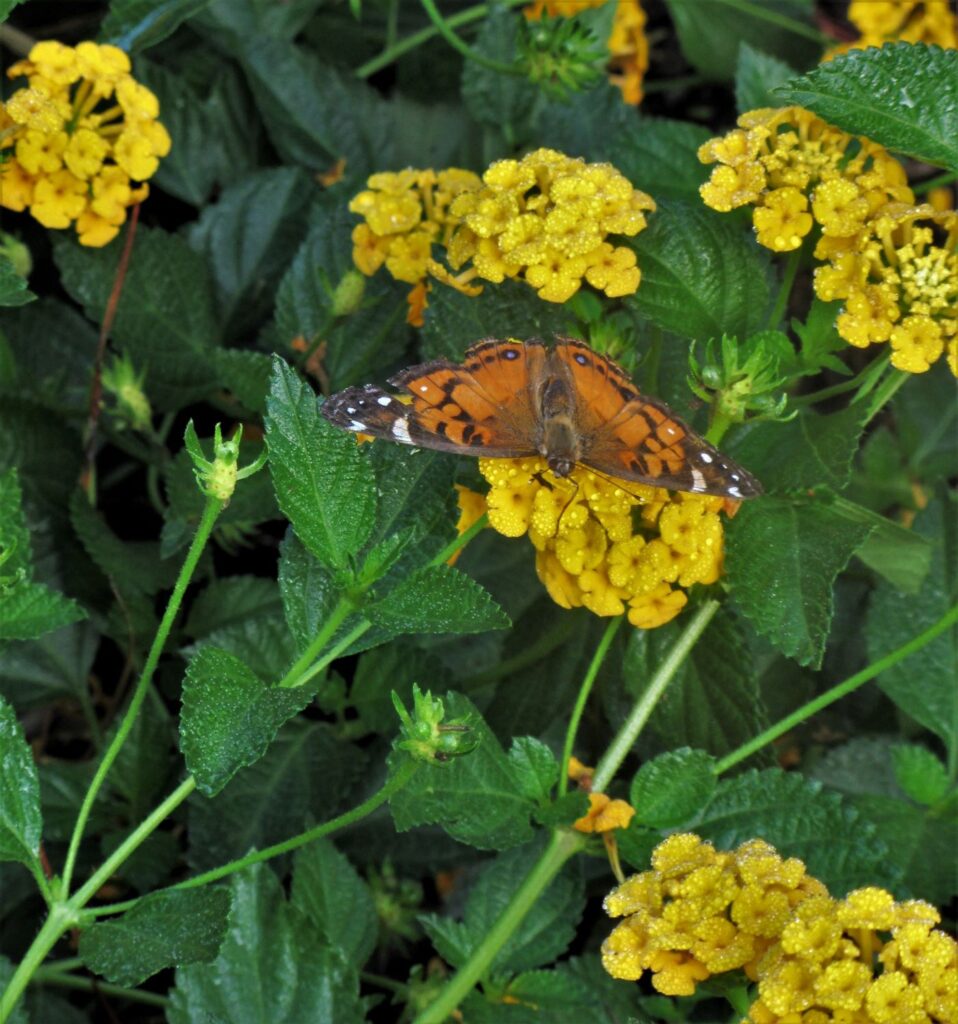
Lantana camara ‘Chapel Hill Gold’ attracts butterflies, hummingbirds, and a wide variety of pollinators from May through frost. It shelters and feeds birds all winter. Originally native to the Southeastern United States from South Carolina to Texas, it has begun to naturalize in our area.
Resilience May Be the Problem
Successful plants, those that make it to the nursery trade and escape cultivation to naturalize, are extremely tolerant and resilient. They are persistent in the environment, tenacious in their survival, and they reproduce successfully, often because of their interrelationships with wildlife. ‘Invasive’ plants are masters of survival. They proliferate only because they interact so successfully with other plant and animal species in their environment. Their flowers support pollinators. They provide habitat and food for a variety of small animals. They live independently, without reliance on cultivation, irrigation, or chemical supports like fertilizers, fungicides, or insecticides. Sustainable gardening practices and permaculture gardens rely on plants that can mainly look after themselves with minimum human intervention.
And these tenacious, successful plants have the superpower to reclaim disturbed and polluted sites to reestablish plant communities and functional ecosystems in areas that man has abandoned, like old industrial sites, empty homes and vacant lots, waste dumps, and uncultivated agricultural fields. Pioneer species stabilize and repair compacted and polluted soils. They absorb heavy metals and toxic chemicals as their roots aerate the soil. Their leaves and roots add organic matter to depleted soils. They attract insects, birds, and other animals to return to long abandoned sites and ultimately nurture the next generation of plants in an improvised succession appropriate to their biome.
Let’s Be More Curious
When ‘invasive’ plants colonize a disturbed area, our curiosity should lead us to question, ‘Why?’ Why is this particular plant thriving in this place? How is this plant functioning within the environment? Nature has her own wisdom and is master of energy flow from form to form. She is also unconcerned with the pedigree and provenance of a useful plant which can fill a niche within an ecosystem. When a certain plant can fulfill a need, and can perform a service for other species, and thrive in the available conditions, then it can take root, grow, and reproduce.
Nature has no vested interest in returning an environment to some snapshot of the past, as some people do. When well-meaning people come to a site to eradicate ‘invasive’ plants to ‘restore’ the ecosystem, nature won’t automatically regenerate plant species indigenous a century or two, or a millennium or two in the past. When the climate has changed, as it has, and the site, soils, and hydrology are changed, that place may no longer support its indigenous flora.

Native Osmundastrum cinnamomeum, cinnamon fern, fiddleheads emerge in a wetland area of the Williamsburg Botanical Garden in March, 2019. This fern prefers acidic, wet soils and often dies when it is planted in dry or sunny locations around homes.
Even when ecologists plant seeds and seedlings to restore what they imagine was there before novel plants arrived, those native species may or may not be the plants needed going forward into the future for that site. And too often, restoration projects don’t include a replanting phase. Instead, those eradicating successful, if novel, plants assume that once they are gone, native plants will regenerate from the seeds lying dormant in the soil or wetland muck. And in practice, the same novel plants, or other novel plants will grow because they are better suited to the site in its current condition.
An unintended consequence of novel plant eradication is loss of habitat and food sources for wildlife. When an ecosystem is destroyed or compromised, for whatever reason, wildlife who depended on those eradicated plants suffer. This loss of habitat is a key factor in recent declines in our wildlife populations.
The War on Phragmites
This is one of the reasons why decades of efforts to eradicate Phragmites in James City County wetlands, and the wider Chesapeake Bay, and elsewhere along the East Coast of the United States, have proven a dismal failure. Gallons and gallons of herbicides are sprayed every year along the James River and its tributaries to eradicate the phrags, and those persistent grasses regenerate from their roots, rhizomes, and seeds as they form thick mats across shallow waterways. Reeds grow on nearly every continent, providing food, habitat, and building materials. Many indigenous cultures depend on them, particularly in areas where wood is in short supply.
There are native Phragmites species in coastal Virginia, but other, larger species came to Virginia during Colonial times on European ships and have naturalized. Burning, cutting, digging their rhizomes, and poisoning with herbicides provide temporary fixes as phrags quickly regenerate. Environmental scientists at the Virginia Institute of Marine Science recognized in a 2008 publication that Phragmites regeneration is most persistent in those areas where they feed on polluted run-off from farmland.
Meanwhile, those systemic, non-specific herbicides approved by government agencies for use in wetlands persist in the soil and water table with unknown consequences for people, wildlife and their potential future environmental impacts on other plant species. Acres of phrags growing in wetlands have been sprayed from airplanes, helicopters, drones, and by individuals on foot or in boats using backpack sprayers for more than 30 years, often in cooperation with groups like The James River Foundation and The Nature Conservancy. It has become common for employees of the agrochemical corporations to serve on the boards of environmental and conservation nonprofits, to give them generous grants, and even to supply herbicides and spraying equipment to aid their efforts in eradicating invasive plant species.
Herbicides sprayed from planes and drones drift on the wind. They may settle on native or ornamental plants, killing them, too. They drift into people’s yards and over people traveling on nearby roadways. Their effects on wetlands and forest wildlife in largely unknown, though some tests on birds and fish have provided enough evidence of animal survival for the EPA to approve their use. While some herbicides degrade within a week or two when exposed to sunlight, they can persist indefinitely underground in soil and groundwater systems.
To Spray, or Not to Spray?
And only in recent years have medical researchers proven links between diseases such as certain cancers, Parkinson’s disease, and other neurological conditions to herbicide use. Meanwhile, these potent chemical weapons for fighting weeds are marketed to homeowners for use in their monoculture lawns of non-native grasses, and to farmers for use in their monoculture fields of soybeans, corn, wheat, and other cash crops. While government agencies test and approve the ‘active ingredients’ in these products, the inert ingredients generally remain untested for their effects on organisms and ecosystems.
The chemical companies marketing herbicides also fund much of the agricultural research at the land grant state universities which provide cooperative extension services to farmers and home gardeners. Federal agricultural research funding was cut significantly in the 1990s under President Bill Clinton, and corporations stepped in to help fund new agricultural research projects at the land grant colleges across America.
Pesticides and Pest Management
These university outreach programs now encourage the use of herbicides to manage and remove certain plant species, identified as ‘invasive,’ from residential landscapes. Conscientious gardeners are taught, through cooperative extension programs sponsored by these universities, that they should eradicate plants like English ivy, Vinca, and autumn olive from their yards so that they don’t ‘escape cultivation’ and ‘contaminate’ the surrounding environment. The Master Gardener curriculum includes instruction in how to apply and recommend herbicides and other pesticides. While Integrated Pest Management is taught to reduce reliance on insecticides, Master Gardener volunteers still learn the fine points of chemical management of lawns, trees, shrubs, and various edible plants.
Meanwhile, millions of American gardeners and homeowners purchase herbicides and expose themselves to them, sometimes in greater concentrations than the packaging recommends, in the interest of eliminating weeds and ‘invasive’ plants from their yards. Without direct training in how to use and store these chemicals, they often put themselves at unnecessary risk and introduce these chemicals into local soils and waterways.
Increasing Biodiversity in Suburbia
Dr. Douglas Tallamy, an entomologist and ecologist at the University of Delaware, published Bringing Nature Home: How You Can Sustain Wildlife with Native Plants in 2009, drawing attention to the decline in native insect and bird species in suburbia. He drew on research his students had conducted to demonstrate how the grass, trees and shrubs found in most suburban landscapes don’t support the local food chain, which is dependent on insects and their larvae. His book drew attention to the importance of biodiversity and native plants in home landscapes. He has gone on to publish additional titles, such as Nature’s Best Hope: A New Approach to Conservation That Starts in Your Yard, and to found the Homegrown National Park movement to increase biodiversity and support wildlife.
Dr. Tallamy observed that by 2005, about 40 million acres of land in America was planted in private lawns, and over 75% of our nation’s land was in private ownership. Nearly 20 years later, many home gardeners now plant a much wider variety of perennials, native grasses, trees, and shrubs to support butterflies and other pollinators, a variety of insects, birds, and other small animals in their yards.
Many now seek out native plants, knowing that some insects are specialists and feed only on certain species of native plants. While it is true that Monarch butterfly larvae feed only on Asclepias ssp., adult butterflies nectar on a wide variety of native, introduced, and hybrid flowers growing on trees, shrubs, herbs, flowering annuals, and herbaceous perennials. Native plants are important, but no longer fill all the environmental niches as our climate continues to shift. Our climate now supports native bees and other insects earlier in the spring and later in the fall, before and after native plants bloom. It is growing too warm and too wet for some plant species indigenous to our area, and species from other, warmer climates, like Southern Magnolia and Scarlet buckeye, have naturalized in our area.
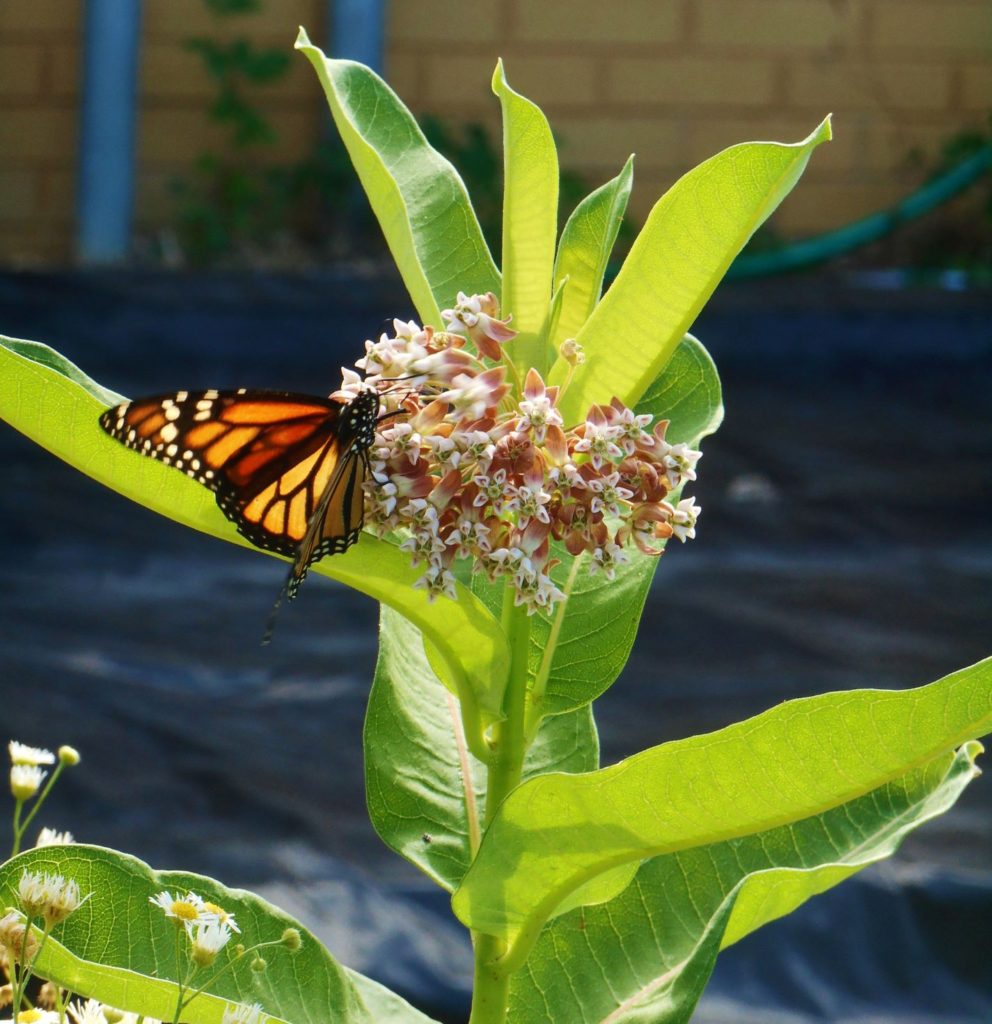
A Monarch butterfly feeds on Asclepias incarnata at the Stonehouse Middle School Native Plant Garden.
Greatest Impact: Keystone Plants
Dr. Tallamy advises that cultivating certain keystone native plant species, particular to our biome, is the most effective way to increase biodiversity because each of these keystone plants, like the oak tree, support hundreds of insect species. These keystone species are the most important ones for supporting the larger web of life because birds and other animals depend on insects for food. A plant that supports hundreds of species is more useful ecologically than one that supports only a few.
In fact, biodiversity, not the percentage of native plants, determines the richness and vitality of an ecosystem. Biodiversity includes plants like clover, dandelions, fleabane, violets, and plantain which support wildlife, but may be considered ‘weeds’ when growing in a lawn. Biodiversity includes plants introduced from Europe, Asia, Africa, the South Pacific, and other regions of the United States, along with the many hybrids and cultivars of these plants that thrive in our area, when they function in the ecosystem and contribute to the beauty and productivity of a site.
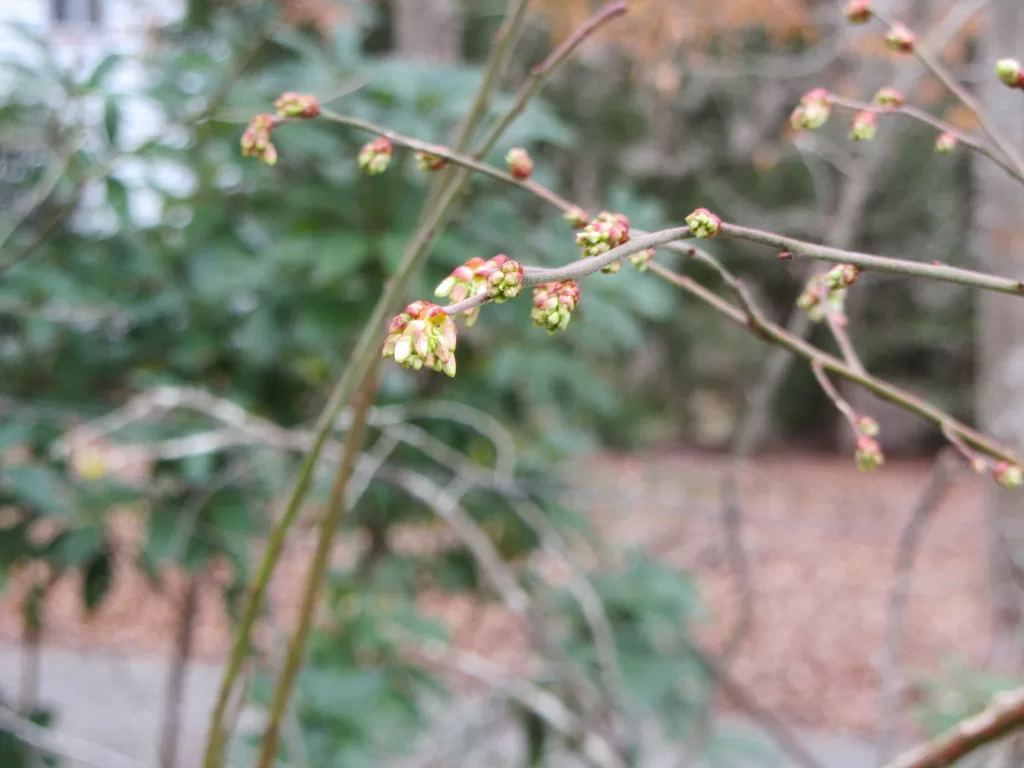
Vaccinium ssp. bloom very early in the season and support over 200 Lepidoptera species and 14 native bee species. They provide edible fruit beloved by birds and other small animals. They are a keystone species in our Eastern Temperate Forest biome, Ecoregion 8. March 2024
Our Future Depends on Functional Plants
In this age of rapid climate change and species loss, growing, breathing plants are crucial to mitigating ecosystem collapse. A plant’s provenance isn’t nearly as important as how efficiently it filters climate altering greenhouse gases like carbon dioxide, methane, and nitrous oxide out of the atmosphere, sequestering carbon and other elements in its biomass and in the soil. We desperately need plants to clean pollutants from the air we breathe; to absorb storm run-off and return the water to the atmosphere; to hold soil against erosion; to absorb sunlight and provide shade; and to support bird and insect species in decline.
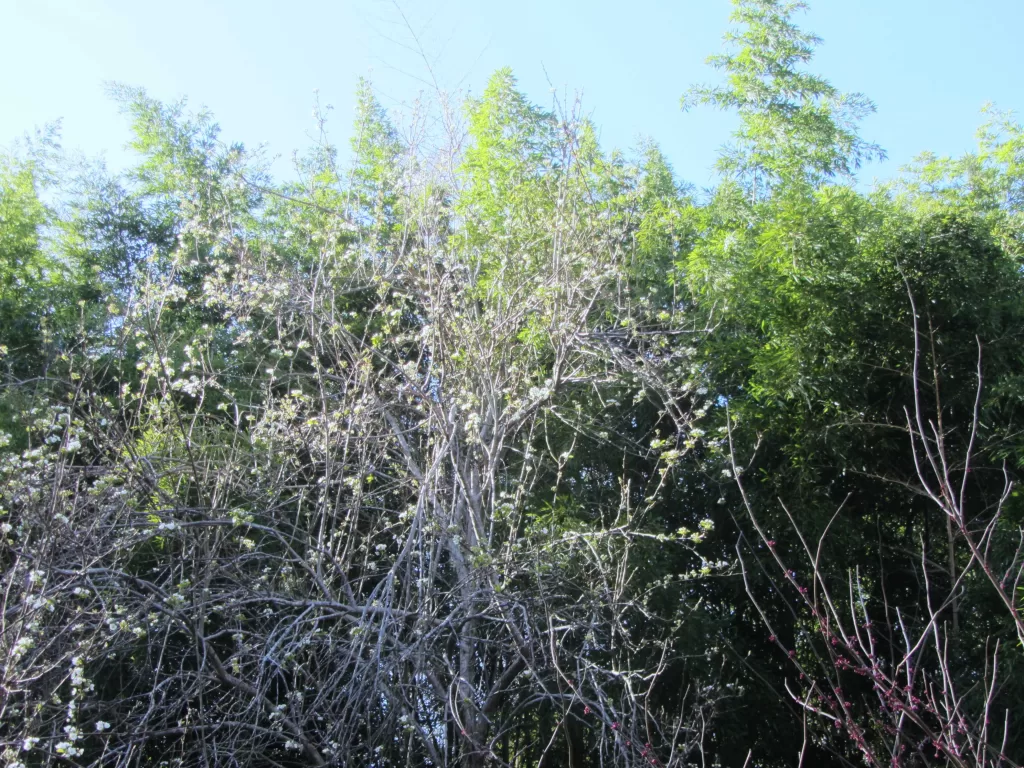
Pear and redbud trees flower in mid-March in our garden. But the evergreen bamboo growing in the Resource Protection Area behind our home is the most efficient at filtering and sequestering pollutants from the air. March 2024
The Case for Bradford Pears
The maligned Bradford or Callery pear, currently in the crosshairs for some Virginia environmental groups, escaped cultivation from where it has been planted in parks and residential yards since the 1960s. ‘Bradford’ was the first named selection of the Callery pear, first planted by USDA employees in a Maryland suburb in the mid 1950s. The USDA introduced the species and it quickly became popular for its beauty, growth habit, and low price. It grows quickly and is resistant to fire blight, which had decimated pear trees already growing in the US by the 1950s. Lady Bird Johnson planted a Callery pear in downtown Washington, DC in 1966 to promote this species. At the time, the New York Times wrote, “Few trees possess every desired attribute, but the Bradford ornamental pear comes unusually close to the ideal.” Several more very popular named cultivars of the Callery pear followed in subsequent years, and they remain popular with landscapers today.
The Bradford pear, once believed sterile, has hybridized with other Pyrus species and now each of its nectar rich flowers can grow into a fertile fruit, beloved by birds. Bradford pears are some of the earliest trees to flower along Virginia roadsides, in parks and neighborhoods, and in abandoned fields in early spring. Their clouds of white flowers brighten a dull, late winter day. You will find native bees, flies, and other pollinators feeding on their flowers whenever the weather is warm enough for them to fly. Birds nest in their branches and later eat their fruits through the autumn.
The Callery ornamental pears, hybrids of Pyrus calleryana, are relatively short-lived, to around 25 years, and are easily damaged in storms because of their dense, upright growth habit. They are pioneer species that root in recently disturbed soil, preparing it for other plants to claim the space around it. The trees are functional within the landscape, and yet, since they are hybrids of an Asian species, Callery pears are on the ‘hit list’ of ‘invasive’ tree species in Virginia. They have escaped cultivation in 25 states and grow as far north as Madison, Wisconsin.
Those who would eradicate this tree aren’t seeing the larger picture of its functionality. This fast-growing tree not only initiates the re-wilding of disturbed areas, but it also sequesters carbon, produces oxygen, provides shade from March through November, supports many types of wildlife throughout the year, and is admired for its spring bloom and fall color. While tourists flock to watch Japanese cherry blossoms in Washington DC, where the Cherry Blossom Festival brings in tourist dollars each year, an equally beautiful Asian tree of a related genus, also in the rose family, is considered ‘invasive’ because it has naturalized and grows beautifully without human tending.
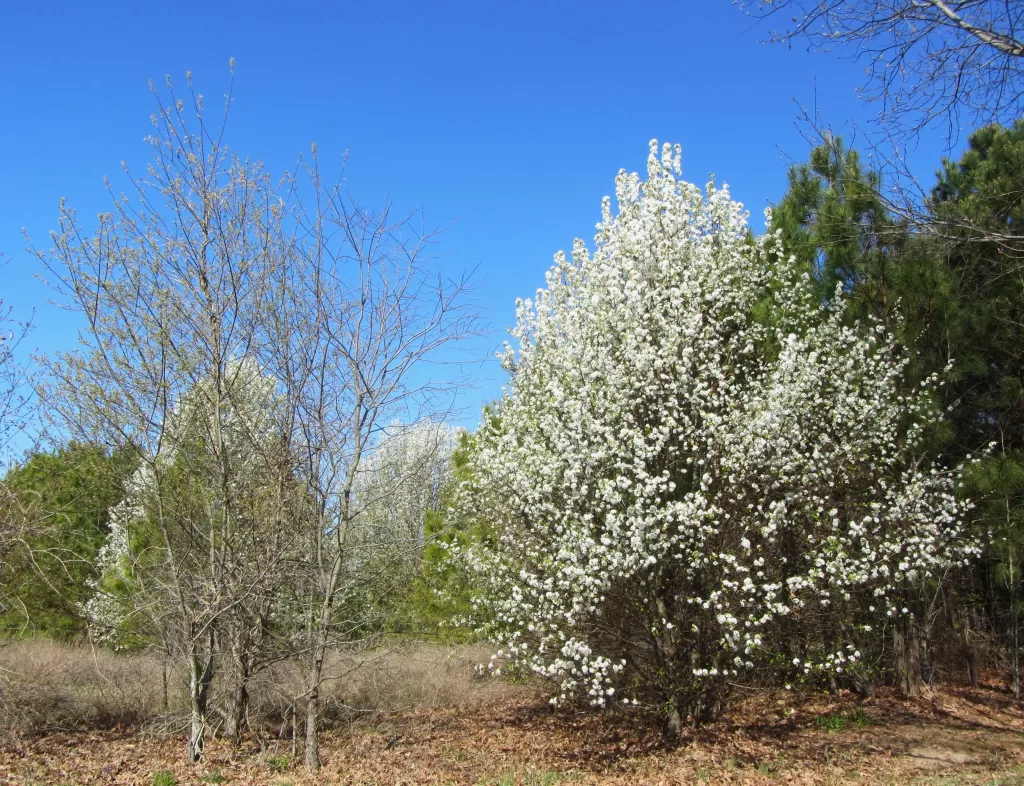
Callery pears grow among other wild trees in what was recently a grassy field on the banks of the James River. March 2024.
What Happened to Nature?
These days, we gardeners and naturalists often look at one another and wonder why our bird populations are in decline. Where are all the butterflies we remember from childhood? What has happened to nature? And how do we restore her? Well, a good start would be to stop destroying her with chemicals and short-sighted sorting of ‘bad plants’ from ‘good’ ones.
We need to take off the cultural blinders of seeing plants only in human terms of profit and loss and move beyond the corporate conditioning of chemical gardening. For the good of our planet, let’s accept plants as “native to planet Earth, indigenous to this part of the universe” as we seek to understand what their presence in a landscape can teach us, and as we appreciate their contributions to the greater whole. Our own long-term survival may depend on reconstructing novel, biodiverse ecosystems on reclaimed land.
All Photos by E. L. McCoy
For More Information:
Blom, Jinny. The Thoughtful Gardener: An Intelligent Approach to Garden Design. Frances Lincoln. 2017.
Culley, Theresa M. “The Rise and Fall of the Ornamental Callery Pear Tree.” Arnoldia. February 2017. accessed 3.20.24. https://arboretum.harvard.edu/stories/the-rise-and-fall-of-the-ornamental-callery-pear-tree/
McCoy, Elizabeth. “Invitation to a Homegrown National Park.” JCCW Master Gardener website. March 2022.
McCoy, Elizabeth. “Noxious or Nice?” JCCW Master Gardener website. January 2022.
McCoy, Elizabeth. “Phragmites in Local Wetlands- Updated”. JCCW Master Gardener website. October 2024.
McCoy, Elizabeth. “What is a Weed?” JCCW Master Gardener website. July 2022.
Miller, Ronald V. Jr. “Monsanto Roundup Lawsuit Update.” Lawsuit Information Center Miller & Zois LLC. March 19, 2024. Accessed 3.20.24 https://www.lawsuit-information-center.com/roundup-lawsuit.html
Orion, Tao. Beyond the War on Invasive Species: A Permaculture Approach to Ecosystem Restoration. Chelsea Green Publishing. 2015.
Pearce, Fred. A Trillion Trees: Restoring Our Forests by Trusting in Nature. Greystone Books. 2022.
Pearce, Fred. The New Wild: Why Invasive Species Will Be Nature’s Salvation. Beacon Publishing 2015.
Scola, Nancy. “Monsanto U.: Agrobusiness’s Takeover of Public Schools.” Global Policy Forum website archives. February 8, 2015. Accessed 3.20.24. https://archive.globalpolicy.org/socecon/tncs/2008/0215monsanto.htm
Scott, Timothy Lee. Invasive Plant Medicine: The Ecological Benefits and Healing Abilities of Invasives. Healing Arts Press. 2010.
Tallamy, Douglas and Rick Darke. Bringing Nature Home: How You Can Sustain Wildlife with Native Plants. Timber Press. 2009.
Tallamy, Douglas. Nature’s Best Hope: A New Approach to Conservation That Starts in Your Yard. Timber Press. 2015.
Tallamy, Douglas. The Nature of Oaks: The Rich Ecology of Our Most Essential Native Trees. 2021.
Vogt, Benjamin. A New Garden Ethic: Cultivating Defiant Compassion for an Uncertain Future. 2017.
Virginia’s Invasive Plant List.
State Arboretum of Virginia Alien Invasive Landscape Plants in Virginia

